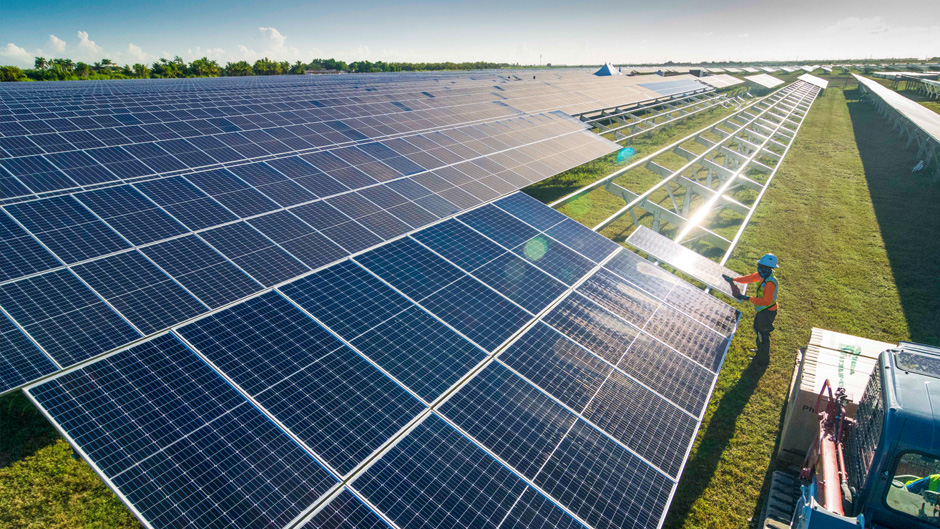The University of Miami will soon become one of the largest higher education institutions in Florida to harness solar energy to power nearly all of its campuses, allowing a drastic reduction of its carbon footprint.
In August, the University will transition to solar energy through a new voluntary program offered by Florida Power & Light (FPL) called SolarTogether. The program allows FPL customers to pay a subscription cost to help the company build solar energy centers across Florida. Then after a period of investment, the customer will receive credits for offsetting the initial cost to subscribe in the program.
“The University of Miami feels privileged to be among the first participants in this program and we hope that its success will lead to more adopters in the near future,” said Jessica Brumley, vice president of the Department of Facilities Operations and Planning. “This partnership with FPL moves the University toward carbon neutrality more quickly and efficiently than we could have achieved independently.”
The University’s interest in sustainability was solidified in 2007, when it joined the American College and University Presidents Climate Commitment, and the Office of Sustainability was created. In 2016, President Julio Frenk renewed the University’s pledge and the goal to reduce carbon emissions 20 percent by 2020, which has been achieved, said Teddy L’Houtellier, sustainability manager.
This was mainly made possible by ensuring that all new buildings received a silver LEED certification from the U.S. Green Building Council—which indicates that buildings save energy, water, and mitigate their impacts on the surrounding environment.
In 2017, the university started using the Sustainability Tracking Assessment and Rating System (STARS) to report on its sustainability performance that includes a greenhouse gas inventory. In 2019, the University earned a STARS gold rating. The main highlights of this rating are available in the Sustainability report 2020.
The electricity purchased from FPL represents more than half of the total greenhouse gas emissions of the University. With SolarTogether, the University will be able to replace the more than 279 million kilowatt hours of electricity it uses each year—currently sourced mostly from natural gas and other sources—with renewable solar energy. This amounts to removing nearly 168,218 metric tons of carbon dioxide or the equivalent of 36,000 gas-driven vehicles, said Alex MacNamara, associate vice president of the Department of Facilities Operations and Planning.
In carbon accounting, explained L’houtellier and MacNamara, Scope 1 emissions are direct emissions generated on site (e.g. fleet fuels), and Scope 2 are indirect emissions generated offsite for energy supply (e.g. purchased electricity).
“UM has very little Scope 1 emissions, so by procuring all its electricity through the SolarTogether program, the University of Miami will become virtually Scope 1 and Scope 2 carbon neutral by 2022. And we will be well ahead of the aspirational goal of carbon neutrality by 2060 that had been set in 2007,” said L’houtellier.
Carbon neutrality refers to the moment in time when an institution is able to reach net zero CO₂ emissions. This can be achieved by balancing those emissions with renewable energy production on site or with carbon offsets. In the case of SolarTogether, the clean energy produced off site will offset emissions by awarding the institution an amount of renewable energy credits corresponding to its total consumption of electricity.
Patrick Casey, vice president of the Department of Facilities Operations and Planning at the University of Miami Health System, said he is proud the University is taking this step to incorporate renewable energy.
"UHealth is thrilled to have committed 100 percent of its electrical demand to the largest-ever solar community program in the United States,” he said. “Our commitment to achieving a carbon neutral enterprise is now cemented for generations to come."
Currently, FPL has 8,000 acres of solar panels in 28 solar energy centers across the state, and it is in the process of building 14 more centers to support the SolarTogether program.
“The University of Miami is a leading participant in the largest community solar program in the nation,” said Matt Valle, FPL’s vice president of development. “The University is helping make solar easier, more accessible, and more affordable than ever and should be proud of the steps it has taken toward a cleaner energy future.”
Added L’houtellier: “Right now, UM’s share of solar in total energy consumption is less than 5 percent. This will change completely as it becomes virtually 100 percent renewable energy.”
For Earth Week, Jessica Brumley, vice president for the University’s Department of Facilities Operations and Planning, will be part of a webinar hosted by FPL that will discuss the SolarTogether program and its impact in South Florida. The webinar will be held from noon to 1 p.m. on April 20. Register here.
Learn more at miami.edu/virtualearthweek.

